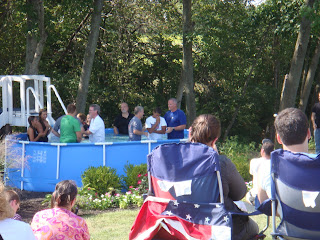As October unofficially announces that fall is here and that football is to take its rightful place atop the mountain we call sports, and as the summer fades for yet another year I can hear Lee Corso faintly proclaim: "Not so fast my friend". October might cause leaves to fall to the ground and for images of first downs to dance in our heads but it also signifies the beginning of the second season for the "boys of summer".
The "Fall Classic", as the World Series is referred to, has granted me with nothing short of wonderful memories and incredible highlights. Whether it is Kirk Gibson hitting a walk off home run on one leg to win game 1 of the 1988 World Series, watching Willie Stargell and the Pirates dance to "We Are Family" as they captured the title in 1979 or Derek Jeter fist pumping the New York Yankees to another World Championship the pleasure that is experienced while watching is wonderful.
Since 1903 our country has watched as baseball crowned it's champion on the grand stage that is known as the World Series. And though baseball is about as American as "apple pie" it is not without its scandal. Baseball has seen the issue of steroids dominate the press for longer than they would like and it has dealt with more than a few people that see no wrong in placing a not so friendly wager on the outcome of a contest. Many are reminded of Pete Rose and his gambling issues but the first gambling scandal of epic proportions was in 1919 and involved the Chicago White Sox.Below is an account of the 1919 scandal from the website www.clearbuck.com
ABOUT
THE 1919 WORLD SERIES SCANDAL
On
September 24, 1919 the Chicago White Sox clinched the
American League pennant, sending them to the World Series.
Their opponent would be the Cincinnati Reds. Just before
the start of the Series, the odds were 5 – 1 in
favor of the Chicago White Sox. But as rumors spread
of a World Series fix, the odds shifted to 8 –
5 in favor of the Cincinnati Reds. The following is
a brief game-by-game account of the 1919 World Series.
It began on
Wednesday, October 1, 1919.
Game
1 – A crowd of 30,511 had gathered to watch the
9 – 1 win by the Reds over the White Sox. The
significant play in game one happened at the bottom
of the first inning when pitcher Ed Cicotte of the Sox
hit leadoff batter Morrie Rath signaling to gamblers
that the fix was on.
Game
2 – With 29, 698 in attendance, the Reds once
again defeated the White Sox to take a 2 – 0 lead
in the Series. Pitcher Lefty Williams walked six batters
in nine innings prompting catcher Ray Schalk to confront
the pitcher in the locker room after the game. Schalk
complained that the starting pitchers were crossing
him up.
Game
3 – The first home game of the Series saw 29,126
in attendance. Down by two games, the White Sox were
able to take game three by a 3 – 0 score.
Game
4 – Ed Cicotte started game four in front of a
crowd of 34,363 in Chicago. After two major fielding
errors by the starting pitcher, the Sox lost to the
Red 2 – 0 and Cicotte experienced his second loss
of the Series.
Game
5 – After a rain postponement, game five drew
the largest attendance of the Series with 34,379. Scoreless
after five innings, the Reds put four runs on the board
in the sixth inning and took the game by a 5 –
0 score. Cincinnati was now up 4 games to 1 over Chicago.
Game
6 – With the Reds up by a commanding lead and
the Series returning to Cincinnati, 32, 006 fans came
out to cheer on the home team. This could be the game
where the Reds would take the Series. After four innings,
Cincinnati was up 4 – 0 but Chicago quickly answered
and had tied the game after nine innings. In the 10th
inning, Buck Weaver crossed the plate to make in 5 –
4 for the Sox. The Reds were now up 4 – 2 in the
Series.
Game
7 – Again in Cincinnati, the White Sox defeated
the Reds 4 – 1 in front of only 13,924 fans. As
the Series headed back to Chicago for game eight, the
Reds were still up in the Series but the White Sox had
cut the lead to only one game.
Game
8 – October 9, 1919 was the final game of the
Series as the Reds defeated the White Sox 10 –
5. In front of a crowd of 32,930 Cincinnati won their
first World Series Championship. For winning in 1919,
each Reds player received $5,207 while $3,254 was awarded
to each White Sox player.
On
September 27, 1920 the 1919 World Series scandal was
exposed. The following day, White Sox pitcher Ed Cicotte
admitted his involvement to attorneys representing Charles
Comiskey. One hour later, Joe Jackson stepped forward,
followed by Lefty Williams. At the end of the day on
September 28, 1920, Charles Risberg, Fred McMullin,
Joe Jackson, Oscar Felsch, George Weaver, C.P. Williams
and E.V. Cicotte were notified of their suspension from
Charles Comiskey.
Within
six weeks, Judge Kenesaw Mountain Landis was named baseball’s
first commissioner. On March 12, 1921 Judge Landis placed
the eight players accused, on the ‘ineligible
list’ and he commented that there was no guarantee
that the players would be reinstated even if they were
acquitted. The trial ended on August 2, 1921 with an
acquittal for all involved. The following day, Judge
Landis released the following statement:
"Regardless
of the verdicts of juries, no player who entertains
proposals or promises to throw a game, no player who
sits in conference with a bunch of crooked players and
gamblers where the ways and means of throwing games
are discussed and does not promptly tell the club about
it will ever play professional baseball."
It
is important to note, the rule forcing players to disclose
gambling information was Landis' and did not exist in
1919. Regardless, no ‘Black Sox’ player
ever played professional baseball again.

































